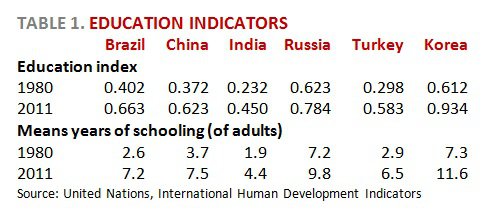The BRICs and Turkey (3)
Its “seventh-grade dropout” adult population coupled with low savings and investment rates do not depict a bright picture about Turkey’s future.
Having a high domestic savings rate is critical so as to raise investments and thus to attain high GDP and per capita income growth rates for a considerably long time frame. For a permanent rapid growth trajectory, however, elements to enhance productivity levels also should be in the work. In terms of domestic savings, Turkey has the lowest rate among the BRICs and Korea. China, India and Korea that have attained stunning growth rates in the recent era not surprisingly have high savings rates.
The middle-income trap
There is the concept known as the middle-income trap: low income countries after a certain point attain high growth rates. In these countries, industries abandoned by advanced countries flourish. The labor force switches from agriculture to industry, which automatically raises productivity levels. These industries start with imitating the advanced country products, and so on. After a certain point, however, their growth slows down. Studies show that for countries stuck in the middle-income trap, high growth continues up until $11,000-15,000 GDP per capita (at purchasing power parity) is achieved while growth rates decrease steeply after this point. Another characteristic of these countries is that they attain high investment rates in the period of rapid growth and maintain currency value low in order to compensate for low productivity.
Of course the middle-income trap is not inevitable; it can be avoided. Countries that were able to avoid it have some characteristics in common. First, the share of the population with secondary education and higher (university and higher) is higher compared to the countries that were stuck in the middle-income trap. Second, high-tech products have a larger share in exports compared to the countries in the middle-income trap (a recent study on this subject by Eichengreen et al can be reached at www.voxeu.org, 11 January 2013).
Seventh grade dropouts
The table below shows some education indicators for the BRICs, Korea and Turkey. The data was obtained from the United Nations, International Human Development Indicators Database. The education index has two subcomponents: mean years of schooling of adults and expected years of schooling of children under seven. The former is involved in the table, the latter is not. The education index varies between 0 and 1, and higher index values represent a higher level of educational attainment vice versa.
These do not give any hint about the university or higher level education, which I will address later. Yet, it is clear that the figures do not augur well for Turkey. Its “seventh-grade dropout” adult population coupled with low savings and investment rates do not depict a bright picture about Turkey’s future. This definitely has to be changed.

This commentary was published in Radikal daily on 15.01.2013




